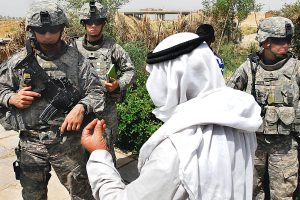
ANALYSIS Twenty years after the US invasion of Iraq, the country is still plagued by sectarian conflict. The US declared quest for democracy went totally wrong, and the US was not seen as liberators, and never understood how to win the peace. The aftermath of the war was violent, with fighting not just between Iraqis, but with links to Syria and ISIS.
In June 2004 a Shiite-led interim government was installed in Iraq. The sectarian conflict that followed was a direct consequence of the US invasion and Saddam Hussein’s fall, where the resulting power vacuum provoked a devastatingly bloody civil war, where most of the victims were civilians and large-scale ethnic cleansing took place around the country.
Both the British and the US troops left the country in 2011. After the withdrawal, the national security responsibilities fell upon the Iraqi forces. Many bombings were conducted and the spiral of sectarian violence between Shiite and Sunni targeted everyone – civilians, government, police and military and Kurds. By mid-2013 Iraq was once again on the path towards full-scale civil war.
Syria is drawn into the conflict
Earlier, displaced Iraqis could escape to Syria. But the two conflicts became intertwined; the Iraqi Sunni minority was inspired by the Sunni revolt in Syria, and many Sunni Muslim Iraqis traveled to join Sunni rebels there. Simultaneously many Iraqi Shiites were fighting for the Syrian regime.
ISIS grows in 2014
In 2014 the bestial jihadist Sunni-group ISIS popped up as a strong, armed force in Iraq. ISIS grew strong in the chaos and power vacuum that had occurred in Syria, and in 2014 it crossed the border to also include Iraq in its struggle to create an Islamic state.
The whole region fell into a new sectarian, full-scale war where Syria, Iran, Iraq and Russia stood on one side and Iraqi/Syrian Sunni rebels on the other, backed up by Israel, the Gulf states and the big Western powers.
At its strongest point ISIS comprised of more than 30 000 troops and had conquered an area the same size as Great Britain, including parts of Syria as well as Iraq, and as much as 40 percent of land mass of the latter.
By mid-2014 the US-led coalition initiated a heavy bomb campaign against ISIS with around 60 participating countries. Thousands of bomb raids were conducted and American ground troops started once again to flow into Iraq.
In 2017, IS was defeated by a US-coalition – and Russia and Iran: a rare combination
By December 2017 ISIS had been defeated in both Iraq and Syria, an achievement that had been reached through various simultaneous campaigns that included the US coalition, Iranian troops/militias, Russian forces/bombings, Iraqi militias, and the Iraqi army.
The 2014-2018 civil war in Iraq resulted in staggering 70 000 deaths and 3.2 million refugees. While ISIS has been defeated as an army on the battlefield, it is still does destabilizing factor in Iraq as well as the entire region, as a terror group. It became obvious that the ISIS-ideology must be eliminated: to defeated ISIS militarily was not enough.
Today – Syria in ruins and an unstable Iraq
Today, Syria lies in ruins and the Al Assad regime has, following an inconceivable number of killed, wounded, tortured, abused, and fled regained control of most of the country, with crucial support from Russia and Iran.
In Iraq, following the defeat of ISIS, there was a slight optimism and a small hope that hadn’t been felt since the US invasion in 2003. Iraq’s military was better trained and showed a stronger loyalty than it did in 2014 and a more positive stance towards US military presence.
But dangers remain and the problems facing the country are still mammoth.
Iraq is squeezed in between Iran’s and Saudi Arabia’s growing rivalry and ambitions in the region, with interference of Iraq’s internal affairs in terms of meddling in elections and influencing politicians and political decisions.
After many years of war against the ISIS, several militias have gained strength, actors that operated parallel to the Iraqi armed forces, and have even gained seats in the parliament. The state lacks monopoly of violence which is an utter condition for a functioning state.
The massive popular protests are another threat to the state’s security. They are the result of dissatisfaction of corruption and the lack of employment and food. After 20 years of war, the Iraqi society lies more or less in ruins, the population is exceptionally traumatized Iraq’s government bodies, before quite effective, have been eroded and ceased to function. There are huge deficiencies in the rule of law, with ongoing, systematic human rights abuses, Illegitimate arrests, torture and death penalties – conducted regularly on arbitrary grounds. The rights of women and children are especially poor.
Another trauma is the enormous amount of war crimes, conducted by ISIS but also Iraqi forces and the Iran-supported Shiite militias.
To sum up: Causes of the war and current realities caused by the war
Publicly, the Bush administration’s main motive to start a war against Iraq was the threat of weapons of mass destruction, which Saddam Hussein was accused of possessing, but never proved to possess. However, a main reason – never officially declared by the Bush government but concluded by researchers, journalists, and other political experts – was to test the effectiveness with preventive wars, to topple unwelcome governments that didn’t coincide with US interests, and embrace the Muslim world from a neoliberal perspective.
The aim was to eliminate the root causes of anti-American terrorism in the Middle East by introducing freedom and democracy, just like the West had helped democratizing Eastern Europe following the end of the cold war. There might also be other explanations for the causes of the war, such as access to oil, financial gains for the arms industry and elimination of threats to Israel. But these cannot be verified at this time.
According to the US doctrine, Iraq was a perfect target. Saddam Hussein was a pariah that no one would miss, the Iraqi military deemed as weak and incompetent, and the population was viewed as secular and thirsty for freedom.
In May 2003, as Saddam had been ousted, the Bush administration declared that the US forces had been welcomed as liberators and that Iraq would be able to finance its own rebuild. It was concluded that other countries in the region would be subdued under the threat of invasion. Such countries were thought to be Syria, Libya and Iran. A swift victory in Iraq would thus open the doors for much else in the region and thereby work as a “domino plan”. The road to the entire Middle East would thus go through Baghdad.
Realities in Iraq 2023
Today, 20 years after the invasion, Iraq is poor, war-torn, conflict-filled, undemocratic, fragmented, and unequal. The reasons are however more multifaceted than the US invasion alone. Now, maybe more so than 20 years ago, the Middle East at large is characterized by failed states torn by armed conflicts, between states but mainly within states. The conflicts have ethnic and religious components, but are also due to lack of democratic systems and civil rights, social and economic divides between ethnic groups, lack of education and a prevailing culture of patriarchy, traditionalism, conservatism and theocracy. Above these, there are historical and colonial explanations regarding how the states were formed and which elites that grabbed power.
The way forward
It is obvious that while the US aimed to promote democracy, the superpower based its actions on miscalculations and caused decades of brutal warfare which created animosity with Muslims all over the region.
What will largely determine Iraq’s – and the region’s – future is the rivalry between Saudi Arabia and Iran. These strong regional powers must show – and be encouraged to show – political will to ensure Iraqi stability and set aside sectarian strives. But in today’s political environment this can perhaps be viewed as a utopia.
 Filip Ericsson has a master’s degree in Peace and Conflict Studies from Uppsala University. Early in his career he conducted an internship at UNDP in Sierra Leone, worked as coordinator at Johanniter International Assistance in Sudan and as a freelance journalist at The Daily Star Newspaper in Lebanon. Today Filip works with social welfare issues in Uppsala, is active as a freelance writer for different magazines and runs the blog https://varldspolitikifokus.wordpress.com/
Filip Ericsson has a master’s degree in Peace and Conflict Studies from Uppsala University. Early in his career he conducted an internship at UNDP in Sierra Leone, worked as coordinator at Johanniter International Assistance in Sudan and as a freelance journalist at The Daily Star Newspaper in Lebanon. Today Filip works with social welfare issues in Uppsala, is active as a freelance writer for different magazines and runs the blog https://varldspolitikifokus.wordpress.com/
Editor: Gerd Johnsson-Latham
SOURCES:
Andrew J. Bacevich, America’s War for the Greater Middle East, 2017, Random House Inc.
Brookings Institution, https://www.brookings.edu/research/operation-iraqi-freedom-and-the-future-of-the-u-s-military/
Institute for the study of war, http://www.understandingwar.org/report/beyond-islamic-state-iraqs-sunni-insurgency
Global Security, https://www.globalsecurity.org/military/world/war/iraq-civil-war-2014.htm
Defense One, https://www.defenseone.com/threats/2018/03/war-iraq-isnt-done-commanders-explain-why-and-whats-next/146889/
International Crisis group, https://www.crisisgroup.org/middle-east-north-africa/gulf-and-arabian-peninsula/iraq/b61-how-cope-iraqs-summer-brushfire
International Crisis Group, https://www.crisisgroup.org/middle-east-north-africa/gulf-and-arabian-peninsula/iraq/188-iraqs-paramilitary-groups-challenge-rebuilding-functioning-state
Utrikespolitiska Institutet, https://www.utrikesmagasinet.se/analyser/2018/oktober/isis-a-longer-view
Human Rights Watch, https://www.hrw.org/world-report/2018/country-chapters/iraq
Journalist’s resource, https://journalistsresource.org/studies/international/conflicts/crisis-iraq-perspectives-research
The Independent, https://www.independent.co.uk/voices/syria-iraq-isis-yemen-saudi-arabia-iran-trump-wars-coming-to-an-end-a8133356.html
BBC, https://www.bbc.com/news/world-middle-east-14546763
Foreign Policy Magazine, Why Muqtada al-Sadr Failed to Reform Iraq, (foreignpolicy.com)
Al Jazeera, Muqtada al-Sadr: Iraq’s kingmaker in uncertain times | Politics News | Al Jazeera
untitled (belfercenter.org), “Testing the Surge: Why Did Violence Decline in Iraq in 2007?”

Lämna ett svar